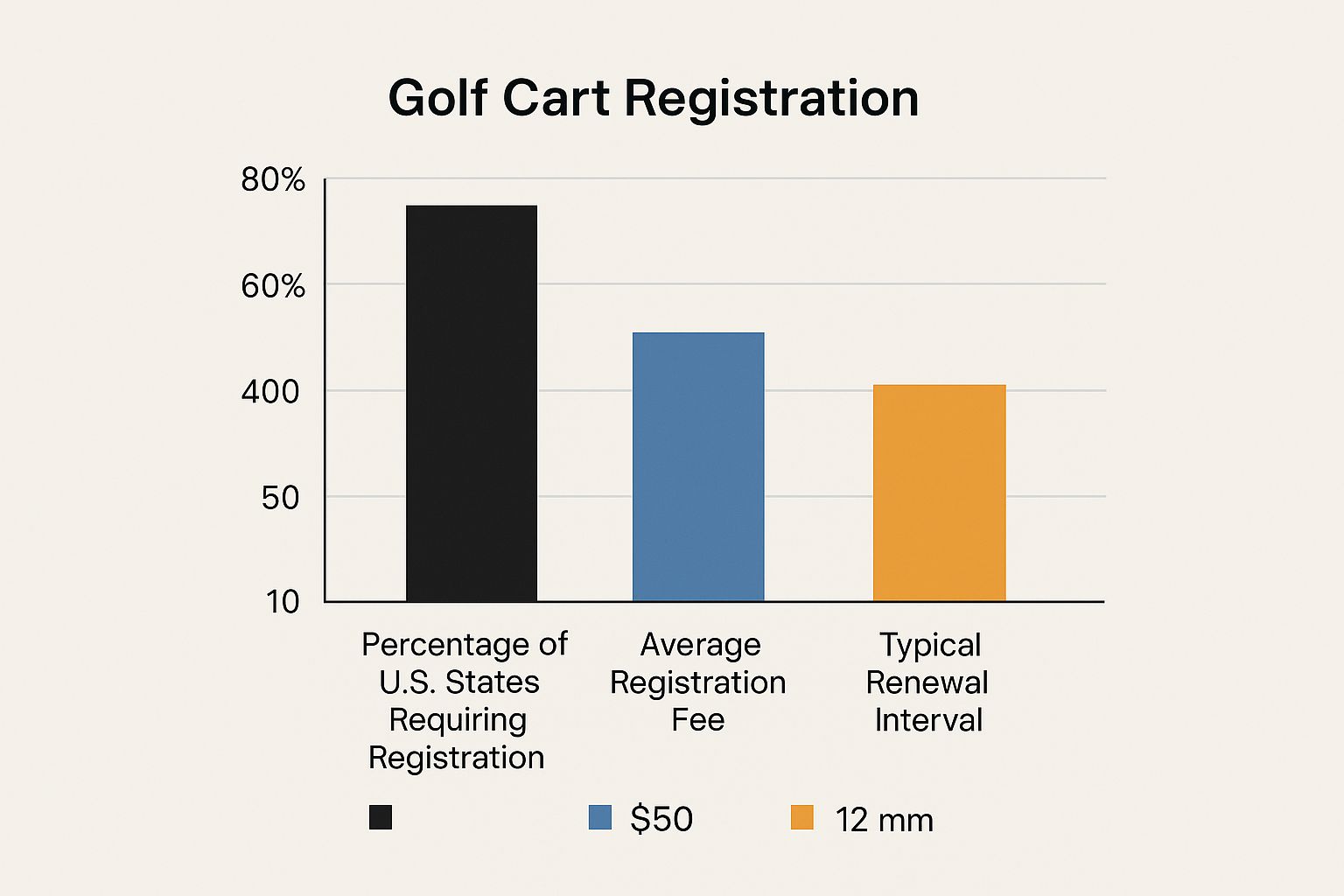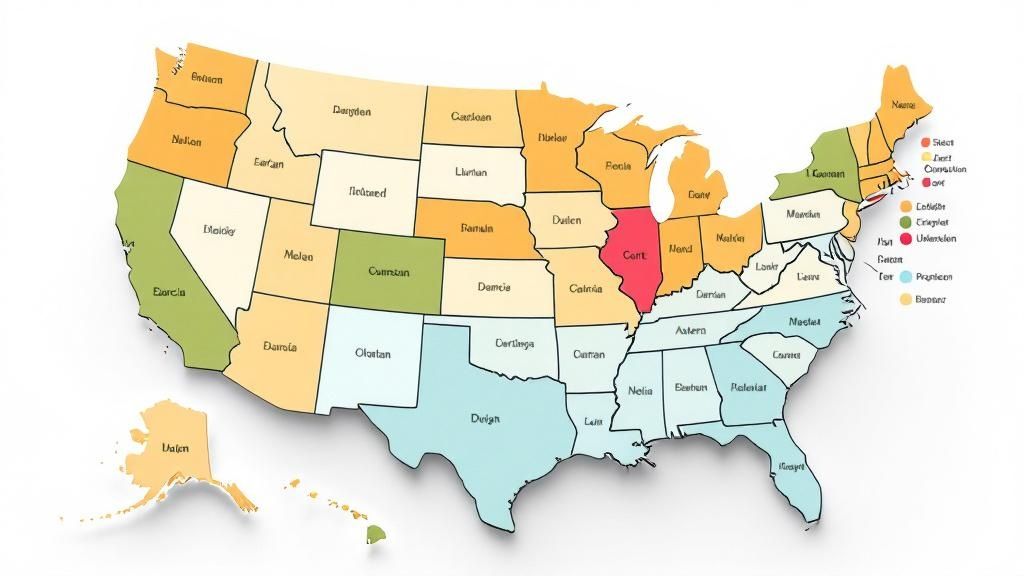First things first, let's figure out if you even need to bother with golf cart registration.
It really boils down to one simple question: will you be driving your cart on a public road? If the answer is yes—even for a short trip to a neighbor's house—then you almost certainly need to register it. Carts that live their entire lives on private property, like a farm or the fairways of a golf course, usually get a pass.
When Does Your Golf Cart Need Registration?
The second your tires hit a public street, your golf cart crosses the line from a fun toy to a regulated vehicle in the eyes of the law. This is the most important distinction to grasp. It's easy to get tripped up here; for example, many people think the roads in their gated community are private, but if the city or county maintains them, they're legally public.
This is where you'll hear terms like Low-Speed Vehicle (LSV) or Neighborhood Electric Vehicle (NEV). These aren't just fancy names—they're official classifications for carts that have been upgraded with specific safety gear required by state and federal law. If you want to drive on public roads, your cart must meet these standards, and registration isn't just a good idea—it's mandatory.
Private Use Versus Public Roads
Here’s a practical way to think about it. Using your cart to haul tools around your own property is no different than using a riding lawnmower. It’s your equipment, on your land.
But the moment you decide to drive that same cart down the street to the corner store, everything changes. It has to be treated more like a car, which means it must be street-legal, carry insurance, and be properly registered with your state.
The key takeaway is simple: Public road access triggers legal responsibilities. This includes not just major streets but also smaller neighborhood roads that you might cross to get from one part of a community to another.
Upgrading to a Street-Legal Vehicle
So, what if your current cart is just a standard model, not built for the road? You'll have to roll up your sleeves and install a few essential safety features to meet those LSV requirements. This step is non-negotiable and has to be done before you even think about filling out registration forms.
We've put together a comprehensive walkthrough on this topic. To see exactly what modifications are needed, check out our guide on how to make a golf cart street legal. This conversion is what officially turns your recreational cart into a vehicle that can get a license plate and legally cruise down approved streets.
Making Sense of Your State's Registration Laws
When it comes to making your golf cart street-legal, there’s no single rulebook. The regulations create a patchwork of laws that can change dramatically the moment you cross a state line. What’s considered perfectly fine in a quiet retirement community in one state could get you pulled over and fined in another.
That's why your first, most important move is to dig into your local and state-specific requirements. Don't just assume your cart is good to go. For instance, a cart that's perfectly legal for zipping around in Arizona might need a whole host of upgrades to pass muster in a place like Florida or California, which tend to have some of the most detailed golf cart statutes on the books.
Strict vs. Relaxed States: A Tale of Two Carts
In states with tighter regulations, you’ll be handed a pretty specific checklist. They get granular, often defining exactly what counts as a Low-Speed Vehicle (LSV) and mandating safety gear like headlights, brake lights, turn signals, mirrors, and a horn. Most of these states will cap the top speed for a street-legal cart at 25 mph to qualify as an LSV.
Then you have states with a more hands-off approach, especially in rural areas. They might only require registration if you plan to drive on certain public roads, giving you a lot more freedom within a planned community or on private lanes. This is exactly why you have to look past general advice and go straight to the source: your state's vehicle code.

As you can see, the vast majority of states do require registration for any kind of road use, but the fees and renewal schedules are usually pretty manageable.
A Quick Look at State Differences
To give you a real-world picture of how much things can vary, I've put together a quick comparison of a few key states. This isn't exhaustive, but it really highlights why you can't rely on what you've heard from a friend in another part of the country.
State Registration Requirement Overview
| State | Registration Required for Public Roads? | Common Speed Limit | Typical Equipment Needed |
|---|---|---|---|
| Florida | Yes, as an LSV. | 25 mph | Headlights, brake lights, turn signals, windshield, seat belts, VIN. |
| Texas | Yes, if on public roads. | 25 mph | Headlights, taillights, reflectors, parking brake, mirrors. |
| Arizona | Yes, as an LSV. | 25 mph | Standard motor vehicle equipment, including lights and mirrors. |
| Georgia | Varies by local ordinance. | Up to 20 mph | Reflectors, brake lights, and a horn are common local requirements. |
This table just scratches the surface. The takeaway is clear: the details matter, and they're found at your local level.
Find Your Local Legal Landscape
With electric golf carts becoming more popular than ever, you're seeing more and more towns and cities creating their own specific rules. In the U.S., if you’re on a public road, you almost certainly need to be registered. States like Florida and Texas are really leading the charge in creating detailed playbooks covering everything from speed limits to how old a driver has to be.
My biggest piece of advice is this: Never assume. Always pick up the phone and call your local DMV or city clerk's office to verify the rules. Getting it wrong can mean fines, getting your cart impounded, or—worst-case scenario—facing serious liability if you're in an accident.
If you want to skip the headache of retrofitting and ensure you’re compliant from day one, it’s often much easier to buy a cart that was built for the road. You can see what I mean by exploring our lineup of road-legal electric carts, which are designed from the ground up to meet these different state laws.
Your Essential Registration Paperwork Checklist

Feeling buried in forms? Let's cut through the clutter. Nothing is worse than spending an afternoon at the DMV only to be sent home because of one missing piece of paper. Getting your documents organized before you go is the single best thing you can do to make this process painless.
The absolute first thing you need is proof that the cart is actually yours. If you bought it new, this will be the Manufacturer's Certificate of Origin (MCO). For a pre-owned cart, you’ll need the original title, properly signed over to you by the previous owner. Without one of these, the DMV won't even talk to you.
Next up is a formal bill of sale. This isn't just a simple receipt. It needs to have the seller's and buyer's names and addresses, the final sale price, the date of the transaction, and—most importantly—the cart's Vehicle Identification Number (VIN). Think of it as the official record of the sale.
Key Documents and Identifiers
Before you even think about getting a license plate, your state will demand proof of insurance. You'll need an active liability policy that meets the minimum coverage requirements for a Low-Speed Vehicle (LSV) in your state. A simple quote won't cut it; have the official insurance card or declarations page in hand.
Your cart's Vehicle Identification Number (VIN) is its unique fingerprint. You need to physically find it on the cart's frame and make sure it perfectly matches the VIN on your MCO, title, and bill of sale. Common spots to check are inside the glove box, on the frame under the driver’s seat, or near the front tires. Any discrepancy here will stop your registration dead in its tracks.
Pro Tip: Bought a used cart and the seller can't find the title? Don't panic. Many states offer a path to getting a "bonded title." It involves buying a surety bond that protects against claims from any previous owners, which then allows the state to issue you a fresh title. It’s an extra step, but it can save a great deal.
Filling Out the Application
Once you have your core documents together, it's time to tackle the state's official title and registration application form. This is where you need to be meticulous. Taking a moment for understanding legal documents can save you from a headache later.
Fill out the application slowly and double-check every single entry before you sign. A simple typo or a small mistake can get the whole thing kicked back, forcing you to start over. Ensuring your paperwork is flawless is a bit like proper maintenance—it protects the value of your cart, much like knowing your golf cart battery lifespan helps protect its performance.
Breaking Down the Costs of Registration

Getting your golf cart registered involves more than just filling out forms—it's a financial commitment. It's smart to get a handle on all the potential costs from the get-go so you can budget accurately and not get hit with any surprise fees.
Your main upfront expenses will happen at the DMV. You're typically looking at a title fee, which legally proves you own the cart, and the registration fee itself, which gets you the license plate. While these numbers jump around from state to state, you can usually expect to pay somewhere in the ballpark of $25 to $75 for both.
And don't forget about sales tax. If you've just bought the cart, the state will want its cut based on what you paid. This can be a significant one-time hit, so make sure it's part of your initial budget calculation.
Factoring In Ongoing Expenses
Once you've cleared the initial hurdles, there are recurring costs you'll need to plan for to keep your golf cart legally on the road. Think of these as the annual upkeep for your registration.
Here are the main ongoing expenses you'll encounter:
- Annual Registration Renewal: Just like your car, your golf cart registration expires. The renewal fee is usually a bit less than the initial cost, often landing between $15 and $50 each year.
- Mandatory Liability Insurance: This is a big one and absolutely non-negotiable for driving on public roads. Your policy has to meet your state's minimum coverage, and the price will depend on your insurance provider and personal history.
- Inspection Fees: Some areas require a safety inspection before they’ll even issue a plate, and some require it for renewals, too. These inspections are usually pretty affordable, often costing around $20 to $40.
Keep in mind, these are just general estimates. The absolute best way to know for sure is to call your local DMV or visit their website. Look for the fee schedule for Low-Speed Vehicles (LSVs). Taking that one simple step will save you from any nasty financial surprises.
Submitting Your Application with Confidence

Alright, you’ve got your documents sorted and the fees figured out. Now for the final step: actually submitting the application. You’ll typically have a couple of options here—either file online through your state's portal or head down to a local DMV or tax office in person.
Frankly, each method has its trade-offs. The online route is convenient, letting you upload everything from your couch. But if there’s a hiccup, you could be stuck waiting for an email to find out what went wrong. Going in person means someone can catch a mistake on the spot and let you fix it then and there, but you might have to sacrifice half your day to long lines.
Avoiding Common Submission Pitfalls
From what I’ve seen, most rejections come down to simple human error. Before you submit anything, triple-check that every single field is filled out. Make sure your name and the cart's VIN are exactly the same across every document. A blank space or a typo is a guaranteed rejection.
Another classic mistake is providing an expired insurance card. Your proof of insurance needs to be current, clearly listing the policy dates and showing you meet the state's minimum coverage for a Low-Speed Vehicle (LSV).
Don’t just glance at your paperwork—scrutinize it. A single missing signature or a typo in the sale price can send you back to square one, wasting valuable time and causing unnecessary frustration.
After You Apply: What Comes Next
Once you’ve hit "submit" or handed over your forms, the waiting game begins. If you're lucky enough to be at the counter, you might get approved on the spot. If you applied online or by mail, especially during a busy season, be prepared to wait a few weeks.
It's interesting to see how the growing popularity of golf carts is changing things. With the global market size projected to hit between USD 1.6 and 2.3 billion, more fleets at universities, airports, and large communities are needing formal registration. This pressure is actually helping to standardize the process for everyone. You can dive deeper into this trend by learning about the golf cart market growth on datainsightsmarket.com.
If everything checks out, you’ll get your license plate and registration sticker in the mail. Congratulations—your golf cart is now officially street-legal
Answering Your Top Golf Cart Registration Questions
Even with a step-by-step guide, you're going to run into some oddball situations. The world of golf cart registration is full of them. Let's tackle some of the most frequent questions I hear from owners to help you sidestep any last-minute headaches.
Getting these little details right makes all the difference. For instance, many people don't realize that their local town or HOA might have stricter rules than the state. It's happening more and more. A perfect example is Goshen, Indiana, where local rules demand an orange safety flag on top of all the usual lights and mirrors.
Do I Really Need a Driver's License?
In short, yes. If you're going through the trouble of registering your golf cart as a Low-Speed Vehicle (LSV) to drive it on public roads, you absolutely must have a valid driver's license. No suspensions, no exceptions. The age requirement also mirrors your state's driving laws, which usually means you need to be at least 16 years old.
Think of it this way: once that license plate is on, your cart is a registered motor vehicle in the eyes of the law. You have to follow all the same rules of the road—stopping at stop signs, adhering to speed limits, and never, ever driving under the influence.
What if My Golf Cart Doesn't Have a VIN?
This is probably the most common roadblock people hit, especially with older carts that were only ever meant for the fairway. If your cart is missing that standard 17-digit Vehicle Identification Number (VIN), you can't just jump into the registration process. You’ll have to get a VIN assigned by the state first.
Here’s what that typically involves:
- Book an Inspection: You'll need to schedule an appointment and bring your cart to an official location. This could be a DMV inspection center or even a specific law enforcement office.
- Verify the Vehicle: An inspector will look over your cart to confirm it’s legit and doesn’t have a hidden or altered VIN somewhere.
- Get Your New VIN Plate: After getting the all-clear, the state will issue a brand-new VIN and attach a permanent plate to your cart’s frame.
Once that new VIN plate is officially on your cart, you can finally move forward with applying for a title and registration.
Don't forget why these rules exist—it's all about keeping everyone safe and accountable on the road. Local police are cracking down, and it's not uncommon to see fines for first-time offenders hitting $175 or more for breaking local ordinances.
Can I Register a Gas-Powered Golf Cart?
You can, but I'll be honest—it’s usually a tougher road. The laws for LSVs and Neighborhood Electric Vehicles (NEVs) were written with electric carts in mind. While a gas cart can be registered, it has to meet the exact same safety standards: working headlights, brake lights, turn signals, mirrors, the whole nine yards.
The biggest hurdle you'll likely face with a gas cart is emissions. Some states mandate that gas-powered LSVs pass an emissions test. For many older carts, especially those with two-stroke engines, passing this test can be a real challenge, if not impossible. Before you sink any money into upgrades, double-check your state's specific requirements for gas LSVs.
Ready to skip the hassle of conversions and compliance checks? Solana EV offers a full lineup of premium, street-legal electric vehicles designed to meet safety standards right out of the box. Explore our models and find the perfect ride for your community at https://solanaev.com.
